Weikai Chen
SPGen: Spherical Projection as Consistent and Flexible Representation for Single Image 3D Shape Generation
Sep 16, 2025Abstract:Existing single-view 3D generative models typically adopt multiview diffusion priors to reconstruct object surfaces, yet they remain prone to inter-view inconsistencies and are unable to faithfully represent complex internal structure or nontrivial topologies. In particular, we encode geometry information by projecting it onto a bounding sphere and unwrapping it into a compact and structural multi-layer 2D Spherical Projection (SP) representation. Operating solely in the image domain, SPGen offers three key advantages simultaneously: (1) Consistency. The injective SP mapping encodes surface geometry with a single viewpoint which naturally eliminates view inconsistency and ambiguity; (2) Flexibility. Multi-layer SP maps represent nested internal structures and support direct lifting to watertight or open 3D surfaces; (3) Efficiency. The image-domain formulation allows the direct inheritance of powerful 2D diffusion priors and enables efficient finetuning with limited computational resources. Extensive experiments demonstrate that SPGen significantly outperforms existing baselines in geometric quality and computational efficiency.
GarmentX: Autoregressive Parametric Representations for High-Fidelity 3D Garment Generation
Apr 29, 2025Abstract:This work presents GarmentX, a novel framework for generating diverse, high-fidelity, and wearable 3D garments from a single input image. Traditional garment reconstruction methods directly predict 2D pattern edges and their connectivity, an overly unconstrained approach that often leads to severe self-intersections and physically implausible garment structures. In contrast, GarmentX introduces a structured and editable parametric representation compatible with GarmentCode, ensuring that the decoded sewing patterns always form valid, simulation-ready 3D garments while allowing for intuitive modifications of garment shape and style. To achieve this, we employ a masked autoregressive model that sequentially predicts garment parameters, leveraging autoregressive modeling for structured generation while mitigating inconsistencies in direct pattern prediction. Additionally, we introduce GarmentX dataset, a large-scale dataset of 378,682 garment parameter-image pairs, constructed through an automatic data generation pipeline that synthesizes diverse and high-quality garment images conditioned on parametric garment representations. Through integrating our method with GarmentX dataset, we achieve state-of-the-art performance in geometric fidelity and input image alignment, significantly outperforming prior approaches. We will release GarmentX dataset upon publication.
TASTE-Rob: Advancing Video Generation of Task-Oriented Hand-Object Interaction for Generalizable Robotic Manipulation
Mar 14, 2025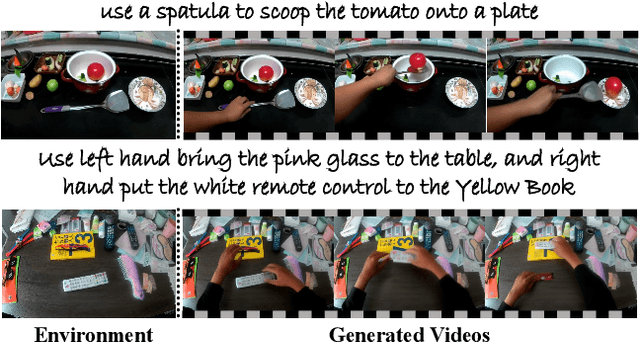

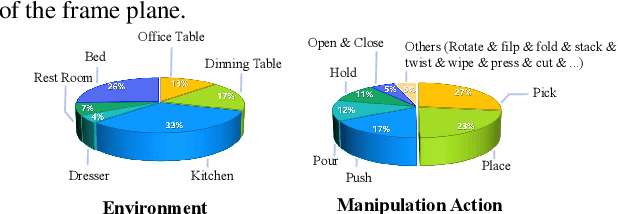
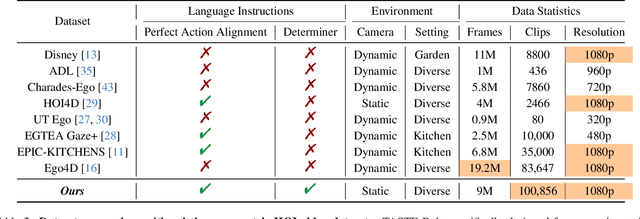
Abstract:We address key limitations in existing datasets and models for task-oriented hand-object interaction video generation, a critical approach of generating video demonstrations for robotic imitation learning. Current datasets, such as Ego4D, often suffer from inconsistent view perspectives and misaligned interactions, leading to reduced video quality and limiting their applicability for precise imitation learning tasks. Towards this end, we introduce TASTE-Rob -- a pioneering large-scale dataset of 100,856 ego-centric hand-object interaction videos. Each video is meticulously aligned with language instructions and recorded from a consistent camera viewpoint to ensure interaction clarity. By fine-tuning a Video Diffusion Model (VDM) on TASTE-Rob, we achieve realistic object interactions, though we observed occasional inconsistencies in hand grasping postures. To enhance realism, we introduce a three-stage pose-refinement pipeline that improves hand posture accuracy in generated videos. Our curated dataset, coupled with the specialized pose-refinement framework, provides notable performance gains in generating high-quality, task-oriented hand-object interaction videos, resulting in achieving superior generalizable robotic manipulation. The TASTE-Rob dataset will be made publicly available upon publication to foster further advancements in the field.
Towards Long-Horizon Vision-Language Navigation: Platform, Benchmark and Method
Dec 12, 2024



Abstract:Existing Vision-Language Navigation (VLN) methods primarily focus on single-stage navigation, limiting their effectiveness in multi-stage and long-horizon tasks within complex and dynamic environments. To address these limitations, we propose a novel VLN task, named Long-Horizon Vision-Language Navigation (LH-VLN), which emphasizes long-term planning and decision consistency across consecutive subtasks. Furthermore, to support LH-VLN, we develop an automated data generation platform NavGen, which constructs datasets with complex task structures and improves data utility through a bidirectional, multi-granularity generation approach. To accurately evaluate complex tasks, we construct the Long-Horizon Planning and Reasoning in VLN (LHPR-VLN) benchmark consisting of 3,260 tasks with an average of 150 task steps, serving as the first dataset specifically designed for the long-horizon vision-language navigation task. Furthermore, we propose Independent Success Rate (ISR), Conditional Success Rate (CSR), and CSR weight by Ground Truth (CGT) metrics, to provide fine-grained assessments of task completion. To improve model adaptability in complex tasks, we propose a novel Multi-Granularity Dynamic Memory (MGDM) module that integrates short-term memory blurring with long-term memory retrieval to enable flexible navigation in dynamic environments. Our platform, benchmark and method supply LH-VLN with a robust data generation pipeline, comprehensive model evaluation dataset, reasonable metrics, and a novel VLN model, establishing a foundational framework for advancing LH-VLN.
GarVerseLOD: High-Fidelity 3D Garment Reconstruction from a Single In-the-Wild Image using a Dataset with Levels of Details
Nov 05, 2024



Abstract:Neural implicit functions have brought impressive advances to the state-of-the-art of clothed human digitization from multiple or even single images. However, despite the progress, current arts still have difficulty generalizing to unseen images with complex cloth deformation and body poses. In this work, we present GarVerseLOD, a new dataset and framework that paves the way to achieving unprecedented robustness in high-fidelity 3D garment reconstruction from a single unconstrained image. Inspired by the recent success of large generative models, we believe that one key to addressing the generalization challenge lies in the quantity and quality of 3D garment data. Towards this end, GarVerseLOD collects 6,000 high-quality cloth models with fine-grained geometry details manually created by professional artists. In addition to the scale of training data, we observe that having disentangled granularities of geometry can play an important role in boosting the generalization capability and inference accuracy of the learned model. We hence craft GarVerseLOD as a hierarchical dataset with levels of details (LOD), spanning from detail-free stylized shape to pose-blended garment with pixel-aligned details. This allows us to make this highly under-constrained problem tractable by factorizing the inference into easier tasks, each narrowed down with smaller searching space. To ensure GarVerseLOD can generalize well to in-the-wild images, we propose a novel labeling paradigm based on conditional diffusion models to generate extensive paired images for each garment model with high photorealism. We evaluate our method on a massive amount of in-the-wild images. Experimental results demonstrate that GarVerseLOD can generate standalone garment pieces with significantly better quality than prior approaches. Project page: https://garverselod.github.io/
MarvelOVD: Marrying Object Recognition and Vision-Language Models for Robust Open-Vocabulary Object Detection
Jul 31, 2024Abstract:Learning from pseudo-labels that generated with VLMs~(Vision Language Models) has been shown as a promising solution to assist open vocabulary detection (OVD) in recent studies. However, due to the domain gap between VLM and vision-detection tasks, pseudo-labels produced by the VLMs are prone to be noisy, while the training design of the detector further amplifies the bias. In this work, we investigate the root cause of VLMs' biased prediction under the OVD context. Our observations lead to a simple yet effective paradigm, coded MarvelOVD, that generates significantly better training targets and optimizes the learning procedure in an online manner by marrying the capability of the detector with the vision-language model. Our key insight is that the detector itself can act as a strong auxiliary guidance to accommodate VLM's inability of understanding both the ``background'' and the context of a proposal within the image. Based on it, we greatly purify the noisy pseudo-labels via Online Mining and propose Adaptive Reweighting to effectively suppress the biased training boxes that are not well aligned with the target object. In addition, we also identify a neglected ``base-novel-conflict'' problem and introduce stratified label assignments to prevent it. Extensive experiments on COCO and LVIS datasets demonstrate that our method outperforms the other state-of-the-arts by significant margins. Codes are available at https://github.com/wkfdb/MarvelOVD
OVER-NAV: Elevating Iterative Vision-and-Language Navigation with Open-Vocabulary Detection and StructurEd Representation
Mar 26, 2024Abstract:Recent advances in Iterative Vision-and-Language Navigation (IVLN) introduce a more meaningful and practical paradigm of VLN by maintaining the agent's memory across tours of scenes. Although the long-term memory aligns better with the persistent nature of the VLN task, it poses more challenges on how to utilize the highly unstructured navigation memory with extremely sparse supervision. Towards this end, we propose OVER-NAV, which aims to go over and beyond the current arts of IVLN techniques. In particular, we propose to incorporate LLMs and open-vocabulary detectors to distill key information and establish correspondence between multi-modal signals. Such a mechanism introduces reliable cross-modal supervision and enables on-the-fly generalization to unseen scenes without the need of extra annotation and re-training. To fully exploit the interpreted navigation data, we further introduce a structured representation, coded Omnigraph, to effectively integrate multi-modal information along the tour. Accompanied with a novel omnigraph fusion mechanism, OVER-NAV is able to extract the most relevant knowledge from omnigraph for a more accurate navigating action. In addition, OVER-NAV seamlessly supports both discrete and continuous environments under a unified framework. We demonstrate the superiority of OVER-NAV in extensive experiments.
Divide and Adapt: Active Domain Adaptation via Customized Learning
Jul 21, 2023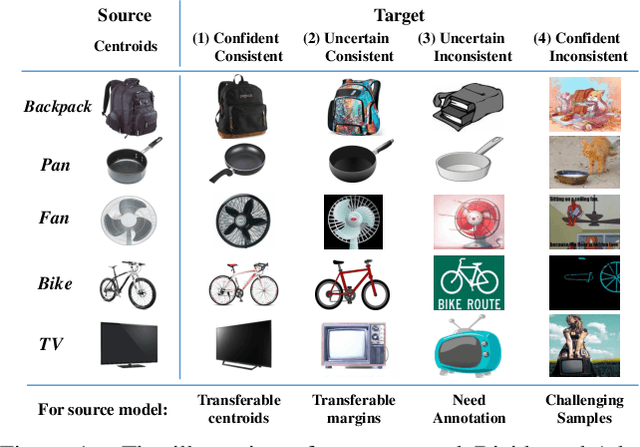

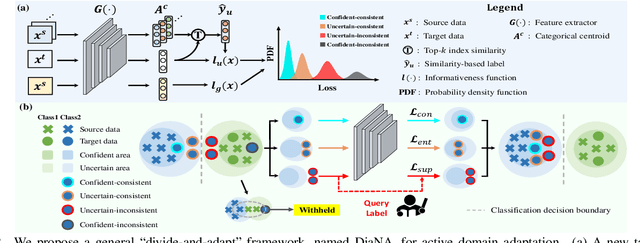

Abstract:Active domain adaptation (ADA) aims to improve the model adaptation performance by incorporating active learning (AL) techniques to label a maximally-informative subset of target samples. Conventional AL methods do not consider the existence of domain shift, and hence, fail to identify the truly valuable samples in the context of domain adaptation. To accommodate active learning and domain adaption, the two naturally different tasks, in a collaborative framework, we advocate that a customized learning strategy for the target data is the key to the success of ADA solutions. We present Divide-and-Adapt (DiaNA), a new ADA framework that partitions the target instances into four categories with stratified transferable properties. With a novel data subdivision protocol based on uncertainty and domainness, DiaNA can accurately recognize the most gainful samples. While sending the informative instances for annotation, DiaNA employs tailored learning strategies for the remaining categories. Furthermore, we propose an informativeness score that unifies the data partitioning criteria. This enables the use of a Gaussian mixture model (GMM) to automatically sample unlabeled data into the proposed four categories. Thanks to the "divideand-adapt" spirit, DiaNA can handle data with large variations of domain gap. In addition, we show that DiaNA can generalize to different domain adaptation settings, such as unsupervised domain adaptation (UDA), semi-supervised domain adaptation (SSDA), source-free domain adaptation (SFDA), etc.
NeUDF: Leaning Neural Unsigned Distance Fields with Volume Rendering
Apr 20, 2023Abstract:Multi-view shape reconstruction has achieved impressive progresses thanks to the latest advances in neural implicit surface rendering. However, existing methods based on signed distance function (SDF) are limited to closed surfaces, failing to reconstruct a wide range of real-world objects that contain open-surface structures. In this work, we introduce a new neural rendering framework, coded NeUDF, that can reconstruct surfaces with arbitrary topologies solely from multi-view supervision. To gain the flexibility of representing arbitrary surfaces, NeUDF leverages the unsigned distance function (UDF) as surface representation. While a naive extension of an SDF-based neural renderer cannot scale to UDF, we propose two new formulations of weight function specially tailored for UDF-based volume rendering. Furthermore, to cope with open surface rendering, where the in/out test is no longer valid, we present a dedicated normal regularization strategy to resolve the surface orientation ambiguity. We extensively evaluate our method over a number of challenging datasets, including DTU}, MGN, and Deep Fashion 3D. Experimental results demonstrate that nEudf can significantly outperform the state-of-the-art method in the task of multi-view surface reconstruction, especially for complex shapes with open boundaries.
NerVE: Neural Volumetric Edges for Parametric Curve Extraction from Point Cloud
Mar 29, 2023



Abstract:Extracting parametric edge curves from point clouds is a fundamental problem in 3D vision and geometry processing. Existing approaches mainly rely on keypoint detection, a challenging procedure that tends to generate noisy output, making the subsequent edge extraction error-prone. To address this issue, we propose to directly detect structured edges to circumvent the limitations of the previous point-wise methods. We achieve this goal by presenting NerVE, a novel neural volumetric edge representation that can be easily learned through a volumetric learning framework. NerVE can be seamlessly converted to a versatile piece-wise linear (PWL) curve representation, enabling a unified strategy for learning all types of free-form curves. Furthermore, as NerVE encodes rich structural information, we show that edge extraction based on NerVE can be reduced to a simple graph search problem. After converting NerVE to the PWL representation, parametric curves can be obtained via off-the-shelf spline fitting algorithms. We evaluate our method on the challenging ABC dataset. We show that a simple network based on NerVE can already outperform the previous state-of-the-art methods by a great margin. Project page: https://dongdu3.github.io/projects/2023/NerVE/.
 Add to Chrome
Add to Chrome Add to Firefox
Add to Firefox Add to Edge
Add to Edge